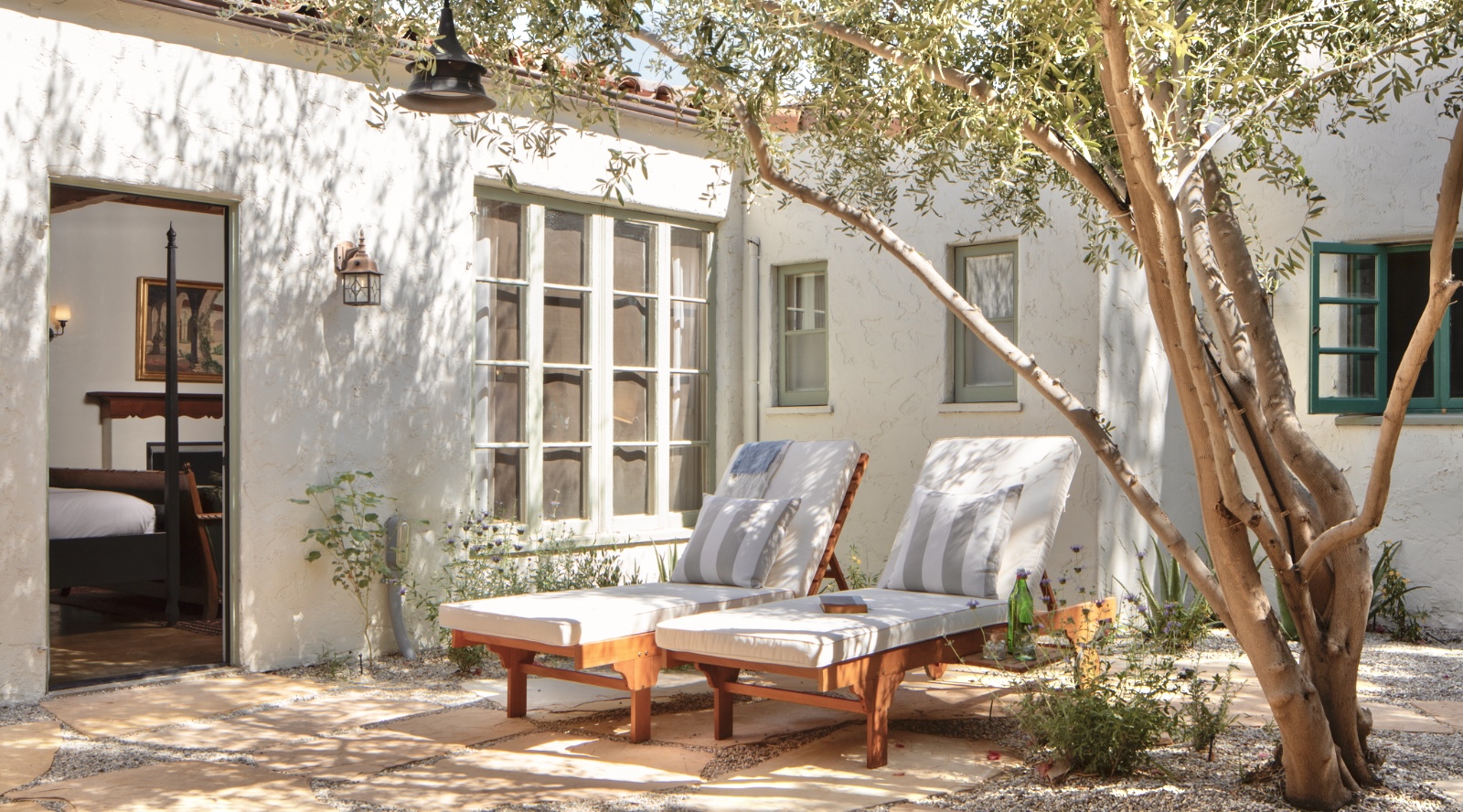Palm Springs has often been regarded as the ultimate destination for a quaint vacation, and a buzzy target for relaxation and stillness. It’s sunny and posh, but still carries a coziness. The slow city has a penchant now for grand airbnbs and towering hotels, but in recent years, as air travel and road trips both have ramped back up to pre-pandemic volumes, with it comes a seeming preference for cozier lodging spaces across hotspot destinations, with vacationers beelining for hotel properties that echo the warmth and familiarity of home in lieu of the near clinical-esque predictability of more standard options.
For Southern California travelers in search of such an experience, there is the Palm Springs gem, Casa Cody. Perched on the western edge of the desert city at the foot of California’s San Jacinto Mountains, the property offers an intimate and luxurious experience with a touch of nostalgia. Surrounded by clusters of palm trees and arches of bougainvillea, the hotel boasts a small footprint of just 30 adobe-style bungalows set against an unobstructed view of a majestic mountainscape. Inside, there’s more square-footage offered per guest than most hotels you’ll come by.

Against the backdrop of urban skylines and bustling streets, the hospitality industry is reinventing itself. The next chapter in travel is not written in grand ballrooms or opulent suites but in the quaint charm of charm-filled lodgings like Casa Cody. Complete private kitchenettes and centered pools that aren’t at risk of overcrowding, you also get that which you might not usually get at home such as massages, reiki sessions and yoga.
Ahead, Casetta’s Brandi Russell, Vice-President of Marketing and Sales at Casa Cody’s parent company, chats with Beyond The Pines about the charm of a cottage stay in the California desert, and the art of a lodging experience that breeds comfort and familiarity.
BEYOND THE PINES: What is at the heart of Casa Cody’s ethos?
Brandi Russell: Casetta was founded by boutique hotel lovers excited by the challenge of giving storied properties new life. Our hotels are architecturally significant, in some cases historic, and often hidden gems. We dig into each building’s history, honoring the past while designing for the future, collaborate with our partners and artists to design spaces that speak to each property’s locale, and spend time with our communities, aiming to create special hotels that resonate with each guest.
BTP: What are the advantages of opting for a bouquet hotel stay versus a more standard option?
BR: We love visiting boutique hotels as they feel closer to a home away from home. The guest experience is more intimate and personal when done right. There’s usually a sense of thoughtfulness that is so thorough, yet not calculated.
BTP: What makes Casa Cody unique in comparison to other boutique properties in Palm Springs?
BR: The history. Casa Cody is the oldest operating hotel in Palm Springs founded in the 1920s by female pioneer Harriet Cody, cousin to the legendary Buffalo Bill. In the early 1900s, Harriet and her husband, Harold Bryant Cody, traveled by wagon from Hollywood to Palm Springs. They settled on the land to become Casa Cody and built a home. By the 1920s, Harriet established the property as a hotel, and it became the stomping grounds for legends of the Los Angeles arts community visiting the desert. Charlie Chaplin, American Opera Singer Lawrence Tibbett, and AnaÏs Nin spent time on property, particularly in the Adobe House, where a stage was built. Tibbett’s piano was kept below the House for performances and parties.
BTP: What are some of the inspirations behind the interior and design?
BR: When we remodel a property, it is very much about maintaining the bones and never transporting the look or feel into another era. We are about breathing in new life, not stripping it away. For Casa Cody, we worked with the designers at Electric Bowery to revitalize the property utilizing rich colors and textures such as the velvet settees you see in many rooms. You’ll see these beautiful zeliage tiles in the showers that feel almost as if they belonged there all along, and the Saltillo tiles take you back in time as you can tell they’re original.
BTP: How do you strike a balance between preserving the antique charm of the property and incorporating modern comforts?
BR: For Casa Cody I think it plays into the design choices that were made. The bathrooms clearly needed to be updated, but the tile feels as if it could have been there all along. It’s making a conscious decision to not do anything too bold at the end of the day. Paint colors are subtle yet current, and landscaping by Terremoto — nothing feels too recent, trendy or modern. You still drive up to the vintage neon light and enter through a large gate that transports you into what feels like a private estate.
BTP: How do you envision the future of boutique hotels, and what role do you see them playing in the evolving travel landscape?
BR: I think we’ve seen a major shift post Covid where travelers alike want to feel connected now. Whether that’s through guest experience or programming, it is something that’s done best at boutique properties. Larger chain hotels definitely have a very special space in the industry that we respect, but with a greater amount of rooms comes a greater opportunity to disconnect from the guest even if that’s not intentional. Staying small allows us to know guests by names and keep track of their preferences. We’ve also seen a huge increase in the demand for wellness offerings and it’s easier for boutique hotels to quickly adapt to needs like this as they arrive. For example, at Casa Cody we have built a beautiful treatment room for massages and reiki, we regularly host sound baths and yoga and at our hotels in development we are installing barrel saunas and cold plunge baths.


Leave a Reply